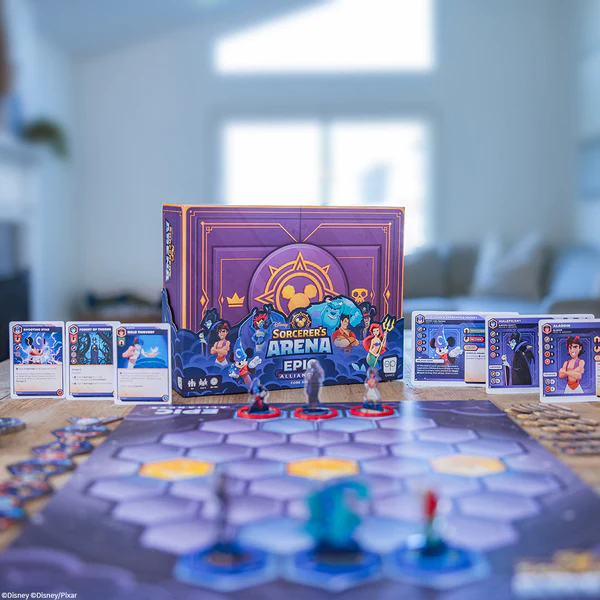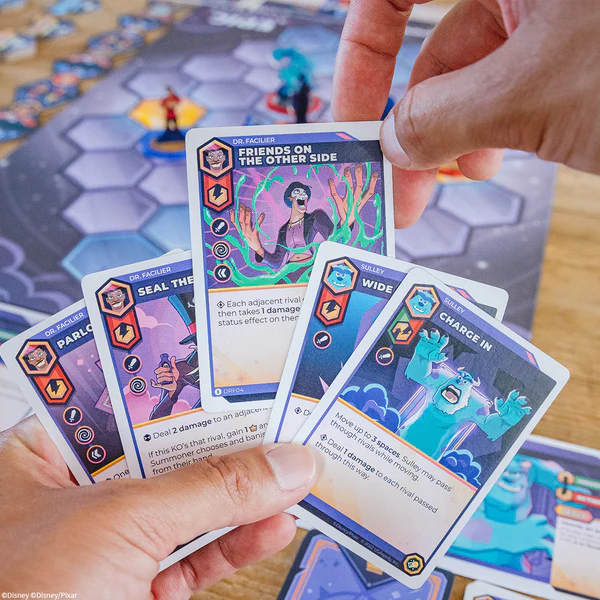Based on a mobile game of the same name, Sorcerer’s Arena: Epic Alliances is a Disney board game in connection with The Op. It’s a very simple game at its core: be the player with the most points. However, the way the game plays can vary in skill level. Built for either two or four players, teams of well known Disney/Pixar heroes and villains are pit against each other.

What’s in the box?
- 8 Character Decks
- 8 Character Ability Cards
- 4 Reference Cards
- 8 Character Turn Order Tokens
- 8 Acrylic Standee Figures with Bases
- 8 Base Rings
- 24 Status Effect Tokens
- 1 Turn Marker
- 15 Status Counters
- 18 Victory Point Tokens
- 1 Arena Game Board
- 1 Summoner’s Handbook
How’s It Play?
To set up the game, players choose three characters from the eight ability cards. To keep one person from being overpowered, player one chooses one card, player two chooses two cards, player one chooses two cards, then player two finishes out by choosing one card. The players then take the respective character decks needed. Each standee figure is placed on its base with the base ring indicator pointed to the maximum health marker. These are then placed in the blue section of the board on the player’s side. To the side of the board, turn order tiles are placed in the desired play order, alternating between red and blue. Turn order tiles show the max health points a character has and the victory points awarded if they’re defeated. Status effect tiles are placed further away from the board with the victory point tokens and status counters next to them.
Sorcerer’s Arena can be played at four different levels. The goal of the game is to have the most Victory Points at the end of the game with different point goals depending on the level. The first level is played with specified teams (Sorcerer’s Apprentice Mickey and Aladdin versus Gaston and Ariel) while the other three levels have teams chosen by the players. This game is character turn based, following the order of the turn order tiles, with the turn marker placed on the active character. When each character has gone, the next round starts.
The game starts by drawing a specified number of cards from the shuffled character decks. In each turn, the player gets an action and a movement. These can be used in either order. The player can either use the standard movements and actions based on the character ability cards or they can play character cards from their hand. To gain victory points, a player needs to take a rival’s character down to zero health or to land on a specialized hexagon. When a character goes down to zero health, they’re put back on a starting spot. In level three, skills on the ability cards can be used. In level four, characters can be upgraded.

The Verdict
It’s a slightly confusing game to learn, but once one level is learned it’s pretty easy to move to the next level. It takes about ten minutes for the game to be fully set up and five minutes to explain how to play to a new player. The age suggestion of 13+ makes a lot of sense because even with level one there are a lot of moving parts. Understanding how the status effect tokens work, for example, was a little more tricky than needed. Luckily, the back of the instruction manual gives a list of what each status effect does. All four levels are pretty fun to play, but as I was teaching someone level two, we realized that having the ability cards ended up being more confusing for the first two levels because the only information needed was printed on the turn order markers (health and victory point values). In those levels the standard movement and damage are two. The number of cards that can be held in hand during the first two levels is six. When level three and four are played, the standard movement, damage, and cards held are based on the character. For example, Aladdin gets a standard movement of three instead of two and Gaston gives a player only one playable card instead of two.
The given abilities stay true to the characters. Gaston’s standard damage is two points but several of his playable cards deal up to six points. Most of Dr. Facilier’s actions apply status effects to rivals. Sulley’s skill lets him move anywhere on the board next to a low health ally and stay immobilized next to them, limiting access from a rival. When upgraded, Maleficent deals one damage to any rival whenever a magic effect card is used. The titles for the abilities are also accurate. Dr. Facilier’s skill is called “Tarot Reading”, Ariel has a movement called “Swift Seas” and Aladdin’s upgrade is “Sleight of Hand”.
The game is very well constructed – to the point that changing the health dial is a little frustrating. It doesn’t twist smoothly and if your acrylic character isn’t able to firmly stand on its base, the entire thing falls apart every time health has to be changed. The cards are bright and well designed. At a first glance the ability cards seem confusing but after a couple level three or four games they’re easy to understand. The game does have a lot of pieces, making set up a little time consuming. Everything other than the cards had to go into separate bags which were then put in the box.
The selection of characters seem rather random – Sulley and Demona being in the same game is unexpected – but the strengths and abilities that each character has makes it work well. A player might choose Dr. Facilier in response to their opponent picking Maleficent because both are spell casters. It’s a well balanced game – with the exception of Sorcerer’s Apprentice Mickey. I understand that as a Disney game, Mickey is an understandable character to have and the only version of him with skills is him as a sorcerer’s apprentice, but his abilities rely on the Magic Broom status effect, which makes little sense.
Sorcerer’s Arena: Epic Alliances is best played as a strategy game. Sure, one can pick characters based on who they like and play accordingly, but the game thrives when characters are more deliberate in how they’re playing the game. It manages to be fun with both modes of play and the increasing levels makes the game have a lasting replay value. Sorcerer’s Arena is a fun way to spend thirty-five minutes or so after the work needed to learn the game is done. It can be picked up from The Op Games for $50.
Rating: 9.5/10
Images and review copy courtesy of The Op Games
Have strong thoughts about this piece you need to share? Or maybe there’s something else on your mind you’re wanting to talk about with fellow Fandomentals? Head on over to our Community server to join in the conversation!

